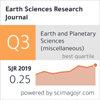Modeling of the large Miocene epithermal and porphyry gold deposits of Colombia using Monte Carlo simulations
IF 0.5
4区 地球科学
Q4 GEOSCIENCES, MULTIDISCIPLINARY
引用次数: 0
Abstract
The Cauca metallogenic belt is an inter-Andean area located along the Cauca-Romeral fault zone, which is made up of a group of twelve Miocene magmatic-hydrothermal Au-Ag-Cu mineral deposits positioned between the Western and Central Cordillera of Colombia. In addition to being a widely developed region in exploration and exploitation with known Au endowments of over 1,700 tons, this area represents an exceptional metallogenetic laboratory for modeling a typical Andean-type mineralization from a calc-alkaline source with high Sr/Y ratios. Efficiency processes such as ion and halogen transport, oxygen fugacity and sulfur content have been extensively studied with a geochemical approach; however, the quantification and modeling of these efficiency processes currently debated. Through multiple iterations using Monte Carlo simulations (N > 2 million), the modeled reservoirs corresponding to the upper crust, using a high flux of dacitic magma of 0.007 km3/year and efficiencies of 1 – 2 %, showed that gold endowments bear heavily with magmatic and hydrothermal Au deposits in the Cauca Metallogenic Belt. Outcomes including Au endowments up to 1,000 tons can be obtained for reservoirs below 400 km3 of hydrous melt in brief mineralization intervals between 40 to 120 ka and for volumes of 400 to 800 km3 in a 120 to 200 ka window. In contrast, the hypothetical reservoirs for the lower and middle crust, through a basaltic calc-alkaline magma flux between 0.0007 and 0.0011 km3/year, an efficiency of ~0.7%, and pressures below 5 kbar, showed sufficient available content of exsolvable H2O and gold to feed the reservoirs in the upper crust or to generate gold deposits from them, but in longer time intervals (>1 Ma).哥伦比亚中新世大型浅成热液和斑岩金矿床的蒙特卡罗模拟
Cauca成矿带是一个安第斯山脉间区域,位于Cauca-Romeral断层带沿线,由位于哥伦比亚科迪勒拉西部和中部之间的12个中新世岩浆热液Au-Ag-Cu矿床组成。除了是一个勘探和开发广泛的地区,已知Au储量超过1700吨外,该地区还是一个特殊的成矿实验室,用于模拟具有高Sr/Y比的钙碱性来源的典型安第斯型矿化。利用地球化学方法对离子和卤素迁移、氧逸度和硫含量等效率过程进行了广泛的研究;然而,这些效率过程的量化和建模目前仍存在争议。通过使用蒙特卡罗模拟的多次迭代(N>200万),对应于上地壳的建模储层,使用0.007 km3/年的高英安质岩浆通量和1–2%的效率,表明金的禀赋与考卡成矿带的岩浆和热液金矿床有很大关系。在40至120ka的短暂矿化间隔内,含水熔体储量低于400km3的储层和120至200ka窗口内400至800km3的储层可获得高达1000吨的Au储量。相反,下地壳和中地壳的假设储层,通过0.0007至0.0011 km3/年之间的玄武岩-钙碱性岩浆通量,效率约为0.7%,压力低于5 kbar,显示出足够的可溶解H2O和金的有效含量,以供给上地壳的储层或从中生成金矿,但时间间隔较长(>1 Ma)。
本文章由计算机程序翻译,如有差异,请以英文原文为准。
求助全文
约1分钟内获得全文
求助全文
来源期刊

Earth Sciences Research Journal
地学-地球科学综合
CiteScore
1.50
自引率
0.00%
发文量
0
审稿时长
>12 weeks
期刊介绍:
ESRJ publishes the results from technical and scientific research on various disciplines of Earth Sciences and its interactions with several engineering applications.
Works will only be considered if not previously published anywhere else. Manuscripts must contain information derived from scientific research projects or technical developments. The ideas expressed by publishing in ESRJ are the sole responsibility of the authors.
We gladly consider manuscripts in the following subject areas:
-Geophysics: Seismology, Seismic Prospecting, Gravimetric, Magnetic and Electrical methods.
-Geology: Volcanology, Tectonics, Neotectonics, Geomorphology, Geochemistry, Geothermal Energy, ---Glaciology, Ore Geology, Environmental Geology, Geological Hazards.
-Geodesy: Geodynamics, GPS measurements applied to geological and geophysical problems.
-Basic Sciences and Computer Science applied to Geology and Geophysics.
-Meteorology and Atmospheric Sciences.
-Oceanography.
-Planetary Sciences.
-Engineering: Earthquake Engineering and Seismology Engineering, Geological Engineering, Geotechnics.
 求助内容:
求助内容: 应助结果提醒方式:
应助结果提醒方式:


